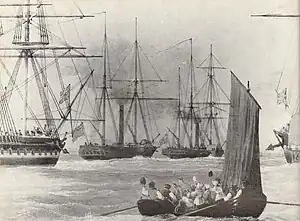HMS Shearwater (1837)
HMS Shearwater was a wooden paddle steamer which became the main surveying vessel in the UK in the 1840s. Shearwater was built in Harwich in 1826 for the Post Office, transferred to the Royal Navy in 1837, and equipped for surveying at Woolwich in 1841. Her length was 137', beam 23'.[1]

The first task, under the command of Captain John Washington, was to complete the great survey of the North Sea which had occupied Captain William Hewett for 10 years until the loss of his ship HMS Fairy with all hands in 1840.[2] While in the North Sea, Washington also continued Hewett's work on tidal observations, verifying the theory of William Whewell that there should be a point in the southern North sea where there is no tidal rise or fall - what is now called an Amphidromic point.[3][4][5]

Captain Charles Robinson took command of Shearwater in January 1842, and carried out surveying work, mostly in western Scotland, until 1847.[6]: 45 Shearwater, along with other surveying boats was then sent to help with famine relief in Ireland, and from 1848 surveying work in home waters was carried out in hired ships[6]: 10
In August 1851 Lieutenant-Commander William Horton took command of Shearwater, with duties in the Mediterranean.[7] She was sold in Malta in 1857.[1]
References
- Rice, Tony (1986). British Oceanographic Vessels 1800-1950. London: The Ray Society. p. 135. ISBN 0 903874 19 9.
- "The North Sea - Sheet 1 - From Dover and Calais to Orfordness and Scheveningen (Review of chart)". Nautical Magazine. 10: 289–291. 1845.
- Washington, John (1842). "Tide Observations - North Sea - Professor Whewell's Theory". Nautical Magazine. 10: 566–569.
- Doodson, A.T.; Warburg, H.D. (1941). Admiralty Manual of Tides. Lonodon: H.M. Stationery Office. pp. 198–217.
- Ritchie, G.S. (1967). The Admiralty Chart. London: Hollis & Carter. pp. 194–195.
- Dawson, Llewellyn Styles (1885). Memoirs of hydrography, including brief biographies of the principal officers who have served in H.M. Naval Surveying Service between the years 1750 and 1885. Part 2. - 1830-1885. Eastbourne: Henry W. Keay.
- "HMS Shearwater (1837)". The Royal Navy. Retrieved 2 October 2021.